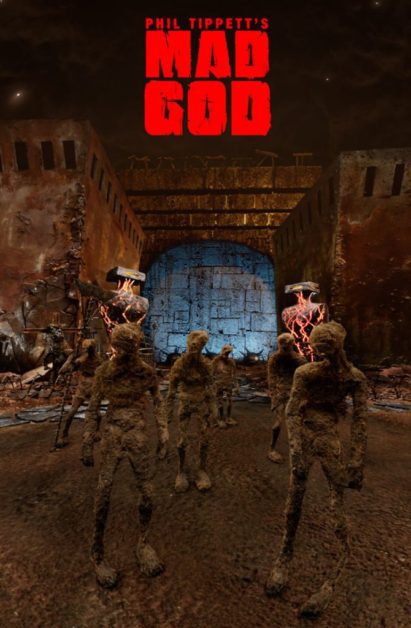For those who may not be familiar with Phil Tippett, please allow me a second to catch you up. A legend in the VFX field, Tippett has worked on and supervised practical and stop motion FX for many of the major formative films of the last century. Jurassic Park, A New Hope, Robocop, Twilight, you name it, and Tippett has had a hand in it. While Mad God isn’t his first directorial effort (that goes to Starship Troopers 2), this is his big blowout effort. When I call it a magnum opus in the title, I don’t use the term lightly. Utilizing a largely volunteer crew over a span of 30 years, Tippett organized an enormous effort of a film, the likes of which I’ll likely never see again.
Synopsis for Mad God (2021):
A corroded diving bell descends amidst a ruined city and the Assassin emerges from it to explore a labyrinth of bizarre landscapes inhabited by freakish denizens.
In the horror genre—especially among other critics who need movies be classified under a subgenre—Mad God defies expectations and classification. If something revolts and terrifies, then it’s likely in this film. If it requires a Viewer Discretion Advised label on TV, then it’s in here. This film is a nightmarish cavalcade of grisly and macabre imagery, the likes of which I’ve only seen in the artistry of Hieronymus Bosch or Kentaro Miura (rest in peace, struggler). All these images are made better (or worse) by the masterful practical FX on display. Every grisly detail feels like it has physical presence, which only adds to the sense of disgust and unease on the journey. It takes an immense amount of skill in FX work to make me wince more at a stop motion facsimile of a person getting harmed than most live action horror movies of the last decade. There are many sets and FX that straight up wowed me in Mad God, leaving me wondering, “How did they accomplish that, especially in stop motion and miniature scale?!”
On top of the film containing a multitude of grisly, gory, and goopy materials, audiences should be aware that the movie does not have a traditional narrative structure. It is more akin to Christopher Nolan’s Memento, where there is a semblance of one, but you piece it together with little clues you get as you go along, in this case, through a literal hell. You start the story with one protagonist, but end with another one entirely. It does help that both seem to be going after the same goal.

I won’t deny that Mad God may be a bit difficult to sit through for some audiences. However, I felt like there is a lot of thematic reward for those who sit through it all. A major theme I noticed in my viewing is that Hell is a creation of the mass’ apathy and the abuses of those in power, but brought horrifically, artistically, and downright hauntingly to life. Some of the sights, sounds, and ideas this film presents are going to stick with me for a long, long time.
However, while it could be naive optimism on my part, I noticed that Tippett doesn’t create the world without any semblance of hope. There always seems to be at least a spark of it, be it in opportunities for kindness, relief, or escape. You just need to grab it and don’t lose it. When you lose it, and sight of the world and the people around you, is when the misery takes over.
I watched Mad God as a part of the Fantasia Film Festival 2021 programming for its world premiere. There are currently no distribution details available, but keep an eye on PopHorror for any upcoming news!
 PopHorror Let's Get Scared
PopHorror Let's Get Scared





